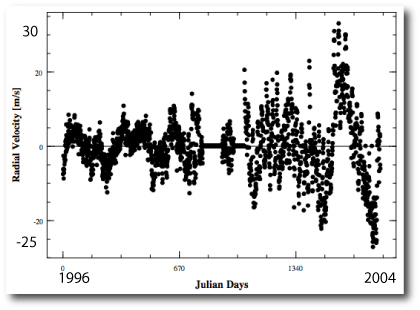
Image Source.
Giant planets are interesting. Terrestrial planets are more interesting. Habitable terrestrial planets are the most interesting of all, and it’s nearly guaranteed that we’re living in the age when the first genuinely Earthlike worlds beyond our solar system will be discovered. The only question is which technique will wind up doing it. The big money is on space-based transit photometry, but I think that ground-based RV might take the prize.
The Systemic Challenge 004 system was designed to be a futuristic idealization of what the Sun’s reflex velocity would like if it were observed with high precision from a neighboring star for more than two decades.
The individual radial velocity uncertainties for the 1172 velocities the Challenge 004 datset are each of order 10 centimeters per second. Errors this small are still safely smaller than the sub-meter per second precision that is currently being obtained by the Swiss team (with HARPS) and the California Carnegie team (at Keck). Given the rapid improvement in the radial velocity technique over the past decade, however, it’s not at all unreasonable to expect instrumental precisions of 10 cm/s fairly soon. Many console users were able to extract the four largest-amplitude solar-system planets — Jupiter, Saturn, Earth, and Venus — out of the challenge004 dataset, suggesting that it’s only a matter of time before instrumental precisions and observational baselines arrive at the threshold where truly habitable, Earth-mass planets can be detected from the ground using the radial velocity technique.
A potential show-stopper for this rosy predictive picture is the astrophysical radial velocity noise produced by the stars themselves. If you want to detect a planet with the mass and period of Earth (which induces a radial velocity half-amplitude of only 9 cm/sec) then you need to be assured that the star is quiet enough for the low-amplitude terrestrial planet signal to be detectable. It’s therefore natural to ask the question: what does the Sun’s reflex velocity look like?
The GOLF experiment on the SOHO satellite provides one set of measurements. A massive time-series of radial velocity observations (from 1996 through 2004) has been published, and is now publicly available. The data set contains over seven million radial velocities taken at a 20-second cadence. The main goal in obtaining this data was to study the Sun’s spectrum of p and g-type modes, which show strongest oscillations at periods of a few minutes.
Three alternate calibrations of the GOLF dataset are posted on the project website. Two of these have clearly been processed to filter out low-frequency, long-period radial velocity variations. It’s interesting, however, to look at what the one unfiltered dataset suggests is happening over timescales of a year or more. I sampled the unfiltered data at a cadence of one velocity measurement per several days, and then loaded the resulting time-series into freshly downloaded version of the systemic console:

According to the above time series, the Sun is a pretty noisy star. I scoured the papers on the GOLF site, and could not find any discussion regarding how much of the variation shown above is believed to come from instrumental effects and how much is belieived to be actually intrinsic to the Sun. The fact that both the scatter and the amplitude of the variations seem to be increasing during the run of the data tend to indicate that intrumental effects relating to the aging of the detector play an important role. If anyone has more specific information on this issue (or if anyone is aware of a preferred calibration) please post to the comments section of the post.
What happens to the detectability of planets that are placed in the GOLF time series? To date, the most precise RV detection of an extrasolar planetary system is the Swiss Team’s discovery of the three Neptune-mass planets orbiting HD 69830. As a control experiment, we relabeled the published HD 69830 dataset at systemic003, and placed it on the backend for Systemic users to evaluate. As expected, nearly all of the twelve submitted fits recovered the published configuration, with chi-square reaching down to about 1.20.
For the systemic004 system, we took the published HD 69830 3-planet orbital model and integrated it forward in time to make a synthetic radial velocity curve. We then perturbed this curve with noise values drawn from the unfiltered GOLF dataset (We averaged the velocities into 15-minute blocks to simulate rapid-fire multiple observations that average over high-frequency p-modes). As of Sunday night, there have been 21 fits uploaded for systemic004 [thanks, y’all, -ed.]. None of them manage a chi-square below 2.5, and aside from the innermost planet, none of them make a convincing case for the presence of the planets that were placed in the dataset. Log in to the backend, call up systemic004 from the “real stars” catalog, and you’ll see what I mean.
The conclusion, then, is that if the GOLF data-set gives a realistic determination of the intrinsic radial velocity variation of the Sun, then the Sun is a far noisier star than HD 69830 (and other similarly old, early K-dwarfs). Indeed, you would even be hard-pressed to believe the presence of Jupiter in the GOLF time-series, unless you’ve got the luxury of waiting for at least several Jovian orbital periods.

Greg-
I would guess that the variation in amplitude of the radial velocity is due to the 11-year solar cycle. The last maximum was in 2000, and we are in solar minimum now. The intrinsic radial velocity scatter doesn’t line up, but synthetic datasets may want to include such a periodic noise… making the planets even harder to detect.
Darin
Hi Darin,
I was wondering about the solar cycle as well, but there’s no evidence of an oscillation in that time-series. It looks more like an exponentially increasing envelope. Also, a 25m/s half-amplitude for the noise variation would presumably be huge for a solar-type star…
Greg